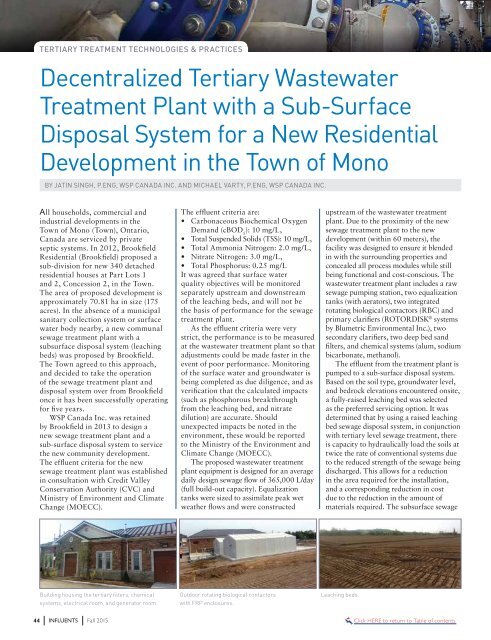lauren@kelman.ca
1YLWYxL
1YLWYxL
Create successful ePaper yourself
Turn your PDF publications into a flip-book with our unique Google optimized e-Paper software.
TERTIARY TREATMENT TECHNOLOGIES & PRACTICES<br />
Decentralized Tertiary Wastewater<br />
Treatment Plant with a Sub-Surface<br />
Disposal System for a New Residential<br />
Development in the Town of Mono<br />
BY JATIN SINGH, P.ENG, WSP CANADA INC. AND MICHAEL VARTY, P.ENG, WSP CANADA INC.<br />
All households, commercial and<br />
industrial developments in the<br />
Town of Mono (Town), Ontario,<br />
Canada are serviced by private<br />
septic systems. In 2012, Brookfield<br />
Residential (Brookfield) proposed a<br />
sub-division for new 340 detached<br />
residential houses at Part Lots 1<br />
and 2, Concession 2, in the Town.<br />
The area of proposed development is<br />
approximately 70.81 ha in size (175<br />
acres). In the absence of a municipal<br />
sanitary collection system or surface<br />
water body nearby, a new communal<br />
sewage treatment plant with a<br />
subsurface disposal system (leaching<br />
beds) was proposed by Brookfield.<br />
The Town agreed to this approach,<br />
and decided to take the operation<br />
of the sewage treatment plant and<br />
disposal system over from Brookfield<br />
once it has been successfully operating<br />
for five years.<br />
WSP Canada Inc. was retained<br />
by Brookfield in 2013 to design a<br />
new sewage treatment plant and a<br />
sub-surface disposal system to service<br />
the new community development.<br />
The effluent criteria for the new<br />
sewage treatment plant was established<br />
in consultation with Credit Valley<br />
Conservation Authority (CVC) and<br />
Ministry of Environment and Climate<br />
Change (MOECC).<br />
The effluent criteria are:<br />
• Carbonaceous Biochemi<strong>ca</strong>l Oxygen<br />
Demand (cBOD 5<br />
): 10 mg/L,<br />
• Total Suspended Solids (TSS): 10 mg/L,<br />
• Total Ammonia Nitrogen: 2.0 mg/L,<br />
• Nitrate Nitrogen: 3.0 mg/L,<br />
• Total Phosphorus: 0.25 mg/L<br />
It was agreed that surface water<br />
quality objectives will be monitored<br />
separately upstream and downstream<br />
of the leaching beds, and will not be<br />
the basis of performance for the sewage<br />
treatment plant.<br />
As the effluent criteria were very<br />
strict, the performance is to be measured<br />
at the wastewater treatment plant so that<br />
adjustments could be made faster in the<br />
event of poor performance. Monitoring<br />
of the surface water and groundwater is<br />
being completed as due diligence, and as<br />
verifi<strong>ca</strong>tion that the <strong>ca</strong>lculated impacts<br />
(such as phosphorous breakthrough<br />
from the leaching bed, and nitrate<br />
dilution) are accurate. Should<br />
unexpected impacts be noted in the<br />
environment, these would be reported<br />
to the Ministry of the Environment and<br />
Climate Change (MOECC).<br />
The proposed wastewater treatment<br />
plant equipment is designed for an average<br />
daily design sewage flow of 365,000 L/day<br />
(full build-out <strong>ca</strong>pacity). Equalization<br />
tanks were sized to assimilate peak wet<br />
weather flows and were constructed<br />
upstream of the wastewater treatment<br />
plant. Due to the proximity of the new<br />
sewage treatment plant to the new<br />
development (within 60 meters), the<br />
facility was designed to ensure it blended<br />
in with the surrounding properties and<br />
concealed all process modules while still<br />
being functional and cost-conscious. The<br />
wastewater treatment plant includes a raw<br />
sewage pumping station, two equalization<br />
tanks (with aerators), two integrated<br />
rotating biologi<strong>ca</strong>l contactors (RBC) and<br />
primary clarifiers (ROTORDISK ® systems<br />
by Blumetric Environmental Inc.), two<br />
secondary clarifiers, two deep bed sand<br />
filters, and chemi<strong>ca</strong>l systems (alum, sodium<br />
bi<strong>ca</strong>rbonate, methanol).<br />
The effluent from the treatment plant is<br />
pumped to a sub-surface disposal system.<br />
Based on the soil type, groundwater level,<br />
and bedrock elevations encountered onsite,<br />
a fully-raised leaching bed was selected<br />
as the preferred servicing option. It was<br />
determined that by using a raised leaching<br />
bed sewage disposal system, in conjunction<br />
with tertiary level sewage treatment, there<br />
is <strong>ca</strong>pacity to hydrauli<strong>ca</strong>lly load the soils at<br />
twice the rate of conventional systems due<br />
to the reduced strength of the sewage being<br />
discharged. This allows for a reduction<br />
in the area required for the installation,<br />
and a corresponding reduction in cost<br />
due to the reduction in the amount of<br />
materials required. The subsurface sewage<br />
Building housing the tertiary filters, chemi<strong>ca</strong>l<br />
systems, electri<strong>ca</strong>l room, and generator room.<br />
Outdoor rotating biologi<strong>ca</strong>l contactors<br />
with FRP enclosures.<br />
Leaching beds.<br />
44 INFLUENTS Fall 2015<br />
Click HERE to return to Table of contents


